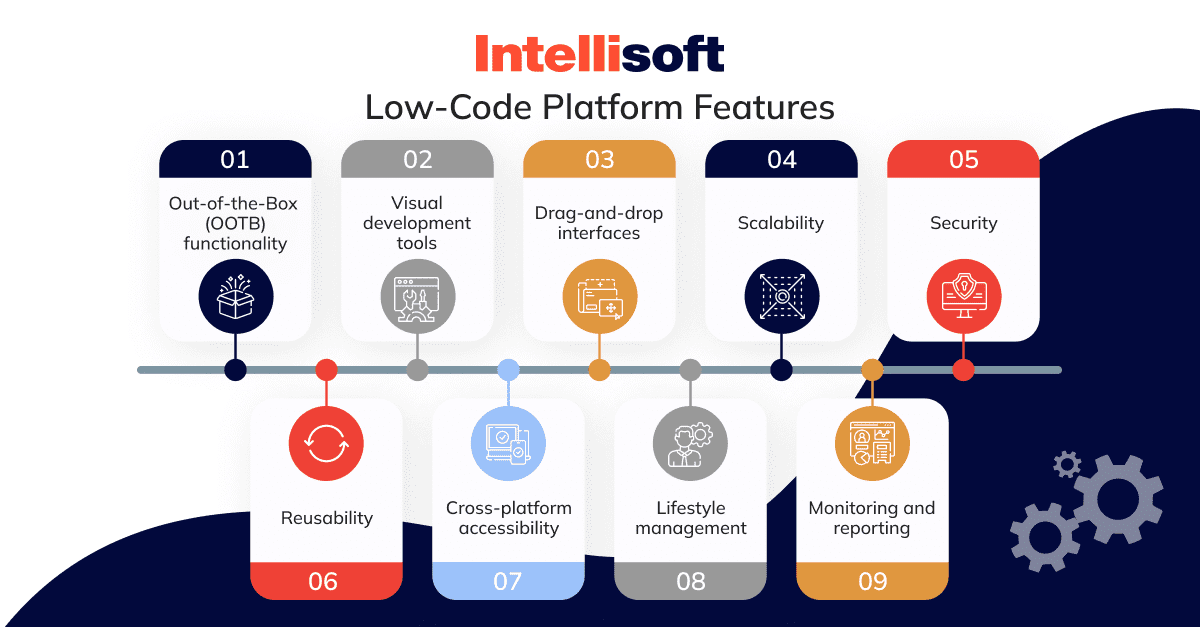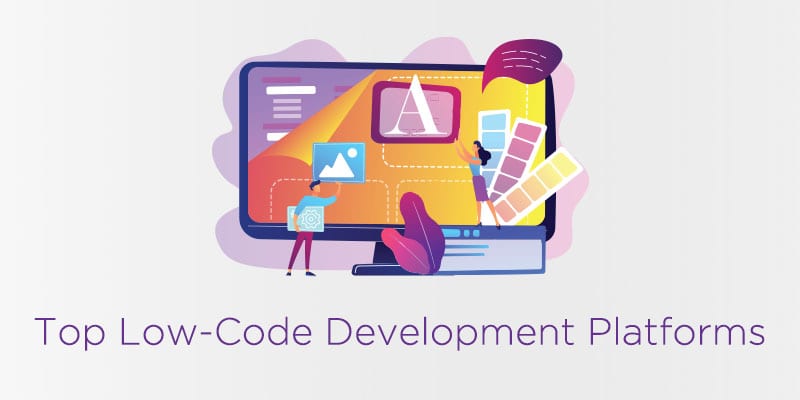Great Facts To Picking Low-Code Platform Sites
Advantages Of Low-Code Application Development In Terms Of Accessibility For Non-DevelopersDue to a number of factors due to a variety of factors, low-code development is more accessible for non-developers. These are sometimes referred to as "citizens developers."
Drag-and-Drop Builders: Low-code platforms come with drag-and-drop interfaces, which allow non-developers develop applications without needing to write code. This makes development more accessible to people who have no or little technical skills.
WYSIWYG editor: "What you see is the result you get" editors allow users to design interfaces, workflows, and other functions in a manner which closely resembles the final product. They are easier to comprehend and use.
Simple Logic and Workflow:
Visual Workflow Design: Users can easily design business process and application logic with diagrams, flowcharts and models. They are simpler to use than traditional programming.
Low-code platforms are often equipped with pre-built logic elements (e.g., conditions statements, loops) that eliminate the need for complicated programming.
Reusable Templates and Components:
Library of Templates Pre-built: A lot of platforms that allow low-code also have templates available for the most common applications. This allows developers to begin their journey quickly and effortlessly while non-developers are able to customize the templates however they see fit.
Reusable modules and widgets: The development of web pages is made simpler by using reusable components as well as modules. This eliminates the need for deep technical knowledge.
Tutorials for Guided Development and Guided Development:
Step-by-Step Instructions: Platforms typically provide a development path that is guided, tutorials, and on-screen tips to assist non-developers in building applications.
Interactive Tutorials Interactive tutorials are interactive and hands-on and help users learn through doing. This improves the confidence of users in the platform.
Integration with tools already in use:
Seamless Integration: Low-code platforms are designed to seamlessly integrate with the existing systems, tools, as well as software (e.g. ERP or CRM, ERP). This allows non-developers who don't have a prior experience in programming to design applications that work seamlessly with their current workflows.
APIs and Connectors: Built-in APIs and connectors make it easier to integrate the process by allowing non-developers to connect their applications to external services without the need for the need for complicated programming.
Collaboration Features:
Team Collaboration: Features such as real-time collaboration, as well as shared workspaces allow non-developers to work with business analysts, professional developers and other stakeholders efficiently.
Access Control Based on Roles: Non-developers are able to have access to roles and levels of access that allow users to contribute, without compromising functionality or security.
Automated Testing & Debugging
Low-code platforms have tools for testing and debugging that are built-in. They automatize the process, making it simpler for non-developers to make sure their apps run.
Error highlighting: The system points out problems and offers solutions to help non-developers.
Low-code development is easier for non-developers to access because it allows for democratization of the development process. Low-code applications allow business users to be involved in the development and maintenance of apps by offering visual tools as well as a guiding experience. This helps bridge the gap between the technical implementation and business requirements. Follow the most popular Low-code Platform for application development for website tips including ms azure sql, azure sql, application modernization, develop web application, mobile app development platforms, develop cross platform mobile app, sso azure, azure sql server, jdbc server, cloud software applications and more.

Scalability And Flexibility Are The Two Main Advantages Of Low-Code Application Development
Low-code application development offers several advantages regarding scalability and flexibility, which are essential for creating applications that adapt to business demands and adapt to changing requirements. Three benefits are listed below.
Cloud-based Deployment : Many low-code platforms are cloud dependent. This allows applications to expand seamlessly with cloud infrastructure. This allows companies to handle increasing loads without worrying over managing servers.
Auto-Scaling Features: Built-in auto-scaling features can automatically adjust resources based on demand, ensuring constant performance during peak times without manual intervention.
Flexible Architecture:
Modular Design: Low-code platforms encourage modularization of applications. This allows components to be designed independently and tested, as well as scalable. This flexibility improves flexibility and facilitates updates or expansions of specific components without affecting the overall system.
Microservices integration: The support for microservices architecture enables applications to be designed as a collection of loosely connected services. This enhances both the flexibility and scalability.
Customizable Solutions:
Extensibility Low-code platforms typically allow custom coding and scripting. This lets developers extend applications' functionality beyond what is available out of the box. This enables unique business requirements to be met without restrictions.
Third-Party Integrations: The ability to integrate with third-party services and APIs allows companies to add additional functions and services as needed, enhancing the application's capabilities.
Agile Development Deployment, Agile Development and Agile Development:
Continuous Delivery and Deployment: Low-code platforms can be used to implement agile methods which allow continuous integration as well as continuous delivery (CI/CD). This allows rapid delivery of updates and new features, which allows applications to evolve quickly in response to customer feedback and changes to the market.
Iterative development: Low-code development is iterative and therefore applications can be scaled up and enhanced incrementally. This minimizes the chance of large-scale changes while allowing a controlled growth.
Resource Optimization
Low-code platforms offer tools to monitor and manage application performance and help to optimize the use of resources. This ensures resources are used efficiently and are easily scaled to meet the actual demands.
Load Balancing: Integrated load balancing capabilities distribute the burden evenly across servers, enhancing the ability of the application to handle heavy traffic and ensuring consistent performance.
Global Reach
Multi-Region Accessibility: Lowcode platforms allow for deployment across multiple regions. Businesses can offer users low-latency access to the world. This is crucial for apps that have a global user base.
Localization Support: The built-in support of localization allows the applications to be easily tailored for different languages and requirements in diverse markets.
Maintenance and Updates
Simplified Maintenance : Low-code applications' visual and modular nature makes maintenance easier. This allows updates and bug fixes be made quickly, with no lengthy downtime.
Version Control Systems that integrate versions control will help you manage updates, rollbacks and other changes. They can make sure that they are released safely and previous version can be restored if required.
Cost Efficiency:
Lower Development Costs: By reducing the need for a lot of coding, low-code platforms lower development costs and allow to scale apps without a substantial increase in cost and effort.
Pay-as-you-go models: Many platforms for low-code users offer a variety of pricing options, including pay-as-you go model that aligns prices and usage with actual growth.
Low-code development offers businesses a number of advantages, such as scalability, flexibility and ad-hoc adaptability. This enables them to develop robust, flexible and scalable applications. These platforms offer quick and efficient responses to changing needs, resource efficiency and continual improvements, making it possible for the development of applications to evolve as a company. Check out the most popular full report for Enterprise application development with Low-code Platform for more recommendations including cross platform mobile app development, no code platforms, azure sql databases, push notifications android, develop cross platform mobile app, develop cross platform mobile app, developing mobile apps, application development platforms, rapid action development, develop mobile application and more.

Benefits Of Low-Code App Development In Terms Limitations And Customization
Low-code is an approach that is balanced and permits substantial customization and overcomes limitations. Here are a few of the main benefits.
Removing Complexity Barriers
Low-code development platforms are easy to use due to the fact that they come with ready-made components, templates, as well as other tools. They also permit quicker deployment of even complicated applications.
A lot of platforms offer automated workflows that help developers navigate their way through the complex processes. They reduce the chance of error and maintain uniformity.
Solutions for scaling:
Built-in Scalability: Low-code platforms include many features that allow for the design of scalable architecture, which allows applications to cope with increased demand without requiring significant changes.
Performance Monitoring: The tools that monitor and optimize performance can help make sure that applications run efficiently even as they expand.
Security and Compliance
Integrated Security Features: Low code platforms come with security measures built in, such as encryption and access control based on role. They also run automated checks of compliance to deal with security concerns.
Regular updates: Platforms often upgrade their security protocols and conformity measures, making sure that their applications are secure against emerging threats.
Customization:
Extensibility:
Low-code platforms let developers expand functionality beyond what is available by integrating custom code.
Custom Plugins and Moduls: Developers may create custom plug-ins or modules that offer specific functions specifically tailored to the needs of a company.
APIs and integration:
API Support: Full API support is available to enable seamless integration and communication with other systems.
Third-Party Applications Lowcode platforms are usually built with connectors for third-party applications, which makes it easier to integrate them and personalize the application.
Flexible UI/UX design:
User interfaces that can be customized: Developers can modify and design user interfaces to meet specific branding requirements and user-friendliness requirements, creating an experience that is customized for users.
Responsive Design: Built-in responsive design capabilities mean that apps can be adapted to different sizes of screens and devices.
The process of customizing Business Logic is easy:
Visual Workflow Builders Visual tools for creating and customizing workflows, as well as business logic allow developers to create complex, tailored processes with no extensive programming.
Platforms can be equipped with conditional Logic that allows the creation of custom scripts to address specific scenarios and business rules.
Data Management
Custom Data Models: Developers are able to define custom data models to fit specific needs of the application, ensuring that data handling is custom-made to meet the needs of business.
Advanced Data Processing: Integration with sophisticated tools and capabilities to process data allows customizing how data is analyzed, and used within your application.
Balancing Customization with Limitations
Frameworks and Standards
Low-code platforms encourage industry best Practices and Standards: Low-code platforms encourage adherence to industry best standards and practices. This makes it easier to maintain top-quality, secure, and scalable applications.
Governance Frameworks - Built-in governance structures ensure that customizations don't interfere with security, integrity or adherence.
Iterative Development and Feedback:
Rapid prototyping: The capability to rapidly prototype and test modifications allows developers to refine their applications based on feedback from users improving the app to meet the needs of users.
Low-code platforms facilitate continuous improvement, allowing for continuous customization and further enhancing as business requirements develop.
User Empowerment
Giving Citizen Developers the ability to be empowered: By giving non-developers the ability to customize their applications through easy-to-use interfaces and low-code platforms they boost the number of users who can enhance and modify the application.
Training and Support - Many platforms offer comprehensive training and resources to support users to customize their applications, while not hindering its stability or performance.
In general, low-code application development offers a solid framework to address limitations and provide ample possibilities for customization. This allows companies to build and maintain functional applications that are tailored to their specific needs, while maintaining high standards for quality, security, and the ability to scale.
